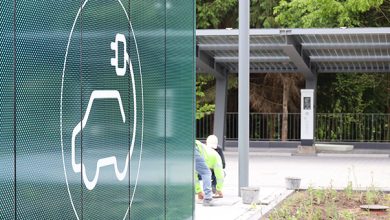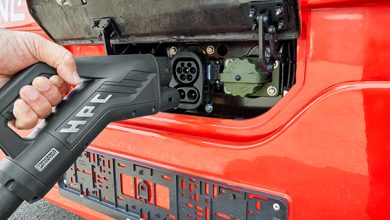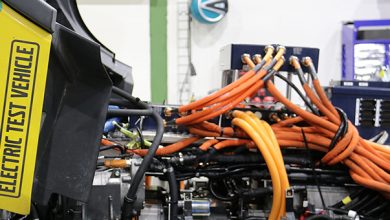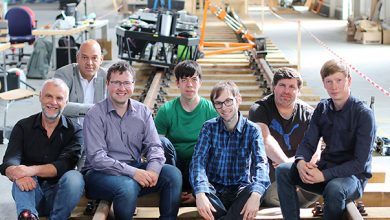It is smaller, lighter and even easier to handle – and yet it can do so much more: the new HPC charging connector from Phoenix Contact E-Mobility achieves up to one million watts of power transmission in combination with the appropriate cable and a suitably equipped charging station.
Even the first High Power Charging (HPC) system, with up to 500 amps of charging power, is a top performer when it comes to fast charging. This is achieved by a cooling system integrated into the charging cable, which can dissipate the heat generated during charging. This is because the enormous amounts of energy that have to make their way into the vehicle through the charging cable really heat up the plastic and copper. Now the developers at Phoenix Contact E-mobility have succeeded in making another drastic leap in performance.

The new HPC charging cable from the CHARX connect professional product family charges vehicles with 800 amps, and in Boost Mode even with 1000 amps, i.e. one megawatt. This enables charging times that come close to those of a classic refueling process. “This means that our products achieve everything that is currently available on the market,” says Florian Grothaus, industrial engineering graduate and product manager for the new HPC generation at Phoenix Contact E-Mobility. “In this way, we enable our customers to provide charging infrastructure that can quickly recharge any vehicle on the market.”
The charging infrastructure is not the only decisive factor here: “Electric cars on the market today are not yet able to handle these charging powers. But our charging connector paves the way for fast charging of even larger battery capacities, for future e-cars, but also for utility vehicles and construction machinery, for example.”
Making the tried and tested better
The highlight: the existing infrastructure does not have to be changed significantly. The optimized cooling concept ensures that the cooling liquid is fed directly through the cable cores and thus cools the cable right up to the contacts. The optimized housing of the new charging connectors is slightly smaller, lighter and easier to handle than that of the first HPC generation – but even more powerful in combination with the charging cable and charging pole. “With this development, we have the opportunity to close the gap between the existing system, which at 500 amps was previously the limit on the market, and megawatt charging, which is still under development,” emphasizes Robert Ewendt. The graduate engineer is HPC Project Manager at Phoenix Contact E-Mobility.
“In addition, with the Combined Charging System (CCS), which Phoenix Contact helped develop years ago in the normative world, we can now also enter the utility vehicle sector. This is now possible thanks to the high performance.” Electrically powered buses or trucks can therefore use the established charging standard and the comprehensive CCS infrastructure with this charging plug.
Private E is not enough
In terms of effort and costs, charging with the Megawatt Charging System (MCS) will probably not be as widespread as the CCS infrastructure. This is because it places new, significantly higher demands on the electricity grid. For charging station manufacturers and operators, capacity utilization and the price/performance ratio must be right, while charging times and prices must be acceptable for freight forwarders. “MCS is currently still a technology issue. Reconciling all requirements is a major challenge,” says Robert Ewendt.
“Technologically, a lot is possible, but it has to be affordable and economical,” adds Florian Grothaus. Once again, pioneering work is needed in the evolution of charging technology. “For a real transport revolution, it is not enough for private individuals to switch to e-cars. We need to take a more holistic view of the transport sector and – wherever possible – electrify it. For this to be successful, the entire bandwidth of possible charging scenarios must be covered. Both cooled CCS cables and the Megawatt Charging System will be important building blocks for this.”
Closing the gap
It is therefore only logical that CCS and MCS charging cables from Phoenix Contact e-mobility are based on the same cooling technology: “With our new HPC charging cable, we are already supplying the right complement to the MCS, as it closes the gap between the previous CCS standard and MCS technology and ensures interoperability,” explains Florian Grothaus. For project manager Robert Ewendt, who co-developed the High Power Charging technology at Phoenix Contact, this is a milestone: “I have been familiar with the topic of cooled charging since it started with us in 2015. Combining water and electricity in one housing was a real innovation. And then also with the requirement to be able to carry 400 and later 500 amps of current,” he recalls.
Series production of the HPC components from the CHARX contact product family began at the end of 2019 – giving the ultra-fast charging pioneers in the Phoenix Contact Group a head start in the market: “The performance is still perfectly adequate to achieve short charging times in conventional vehicles.”
Since 2018, Phoenix Contact has not only been working on defining requirements for the development of the MCS charging standard, but is also already developing its own MCS charging cables and inlets, which will be launched on the market next year. The aim is to achieve charging powers of 1.5 to 3 megawatts – for heavy off-road utility vehicles in mines and on construction sites or for heavy-duty transportation over long distances.
Intended for practitioners
The following detail reveals just how comprehensively the charging technology was conceived and developed: right from the start, the developers and engineers focused on interchangeable contacts and plug faces. This means that charging station operators do not have to dismantle the entire connector for maintenance, but can simply replace the required parts in a few simple steps. These features are also retained in the latest components of the CHARX connect product family – and can therefore turn not only cars, but also electrically powered trucks and buses into charging power millionaires.
(Pia Schlegel)



